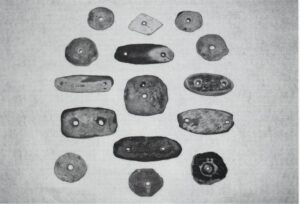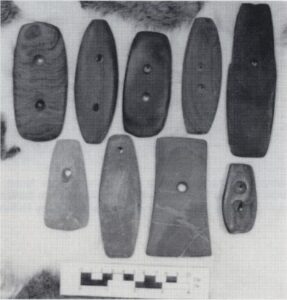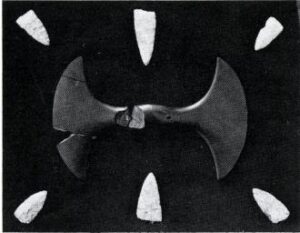SO, what were Bannerstone used for?
Unfortunately, a definitive answer is not yet available. Over the years, numerous researchers have tackled the problem of Bannerstones, only to walk away from their efforts still not knowing for sure what they had been studying. People have long been fascinated by Bannerstones. Their greatest appeal is due to their desirability as an art form. Bannerstones were made in the Archaic period in a myriad of types and styles. Many of the ultimate-design specimens are true masterworks of non-representational art. We have a great desire for a better understanding of these fascinating stone creations with the mysterious drilled holes.
Bannerstone Theories:
- In Gates P. Thurston’s 1890 Antiquities of Tennessee, he uses the term “Bannerstone” when he states “they were doubtless, used as ornaments or symbols upon occasions of ceremony”.
- Warren K. Moorehead uses the term in his 1900 Prehistoric Implements and states, “most if not all appear to have been designed either as ornaments, or emblems, or insignia. By 1910, Moorehead was lumping Bannerstones and other unexplained objects under the heading of “problematical” which defined, very loosely, means–“I don’t know what it is?”
- In 1921, John L Baer reported three crescent shaped slate Bannerstones found in North Carolina. All three banners were mounted on the ends of slate shafts which were approximately one foot long. This lends credence to the early theories that Bannerstones were ceremonial objects indicative of high rank.
- In 1916, Clarence B. Moore published his findings from excavations done at Indian Knoll along the Green River in Ohio County, Kentucky. He found several Bannerstones in association with antler hooks. From his findings Moore surmised that the Bannerstones were net spacers and the hooks were netting needles.
- Dr. George H. Pepper of the Heye Foundation suggested that the hooks and banner-stones were used in conjunction with each other as hair ornaments.
- In 1938, William S. Webb returned to the Green River in Ohio County, Kentucky to conduct excavations. In burial 44, Webb found a butterfly bannerstone and an atlatl hook. Based on Moore’s work and his own work here and in Alabama, Webb proposed the theory that Bannerstones were used as atlatl (spear-thrower) weights placed between a handle and a bone or antler hook. However; In looking at Webb’s work at Indian Knoll Kwas found that out of the total of 880 burials only 43 contained any kind of atlatl object. Of these 43 burials, only 2 contained a bannerstone, hook and handle. One burial contained a bar weight, hook and handle. Kwas seems to be saying that Webb’s research should be considered more carefully and that his atlatl weight theory should not be taken as the ultimate answer to the usage of Bannerstones. 85 percent of the Bannerstones found at Archaic sites were in non-burial contexts, thus indicating that a burial with a bannerstone was a status burial including those of women and children. Howard Winters in 1968 and Nan Rothschild in 1975 reached similar conclusions that Bannerstones were status markers.
- In 1939, Byron Knoblock published his monumental Bannerstones of the North American Indian. Knoblock stuck with the older theories on the usage of Bannerstones. He believed they were ornamental or ceremonial objects. His conclusions were based partly on the fact that certain forms of Bannerstones were usually made from exotic and beautiful material, such as ferruginous quartz or highly banded slate. He also felt that the time expended in making Bannerstones, coupled with their fragile nature, would certainly negate their usage as utilitarian objects.





